Leaf Feeders
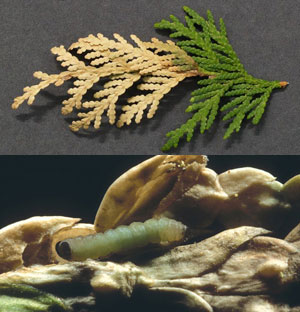
damage: Bruce Watt, University of Maine, Bugwood.org; larva: Connecticut Agricultural
Experiment Station, Connecticut Agricultural Experiment Station, Bugwood.org
Arborvitae leafminer caterpillars are leafminers feeding inside of the leaves. As a result, they are quite small, 1/4 inch long or so, with a black head and reddish green body. The adult moth is also quite small, with fringed wings that are white-grey and speckled with black. When the wings are closed, there appears to be three black bands. Damage appears similar to winter injury, with brown tips appearing in January and February. There will be foliage that is hollow and cracks open to reveal frass if the damage is caused by leafminers. There is one generation per year, with larvae being found in plants throughout the year but adults active in May-July.
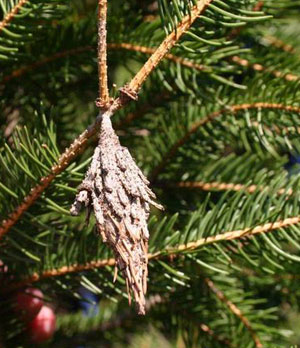
William Fountain, University of Kentucky, Bugwood.org
Bagworms are caterpillars that live in distinctive spindle-shaped silk bags covered with small bits of leaves from the host plant. Large populations of bagworms can strip plants of their foliage and eventually cause them to die. Infestations often go unnoticed because people mistake the protective bags for pine cones or other plant structures. For more information, see Entfact 440.
Sap Feeders
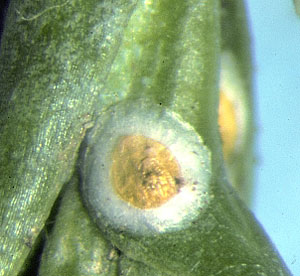
United States National Collection of Scale Insects Photographs , USDA Agricultural Research Service, Bugwood.org
The Minute juniper scale is almost identical to its close relative, the juniper scale. It is slightly smaller than the juniper scale (about 1/16 inch wide) but has the same "fried egg" appearance with a white waxy scale cover that has a yellow-brown dot in the center. Damage can induce early leaf drop and branch dieback. This species overwinters as fertilized females and eggs are laid the next spring. Crawlers hatch in early summer to find new sites to infest.
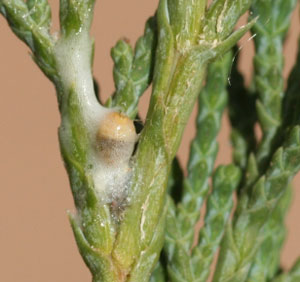
Whitney Cranshaw, Colorado State University, Bugwood.org
The immature nymphal stage is the most noticeable form of the Juniper spittlebug as they produce the frothy mixture that gives the group their name. If you dig through the "spittle" you would find a small dark yellow nymph. Adults are brown and yellow, about 1/4 inch long, and resemble tiny cicadas. The nymphs feed on plant juices and continuously expel bubbles that create the spittle. Generally, this is more of a curiosity than a serious pest.
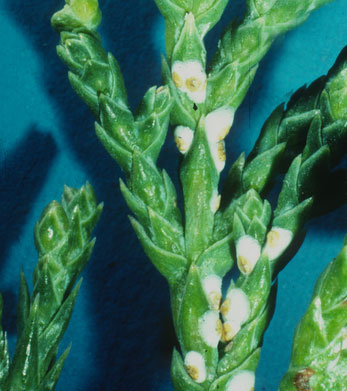
John A. Davidson, Univ. Md, College Pk, Bugwood.org
Juniper scale females are flat and circular, with a white coloration and yellow center, resembling a fried egg. As piercing sucking pests, juniper scale induce yellowing/bronzing and branch dieback as they siphon fluids from the plant. Females are fertilized in the fall and overwinter to lay their eggs in the spring. Eggs generally hatch in mid-May. For more information, see Entfact 429.
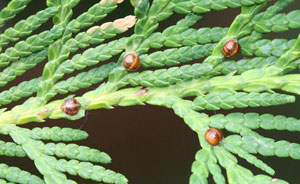
Steven Katovich, Bugwood.org
Adult Fletcher scale females are globular soft scales with a yellow to brown coloration; males become winged reproductives. Immature scales are flatter but swell as they develop. As they feed they can cause tree decline and produce large amounts of honeydew, which can attract other insects and black sooty mold. They overwinter on branches as second instar nymphs and mature the next spring by May. Eggs produced in spring hatch by June/July.
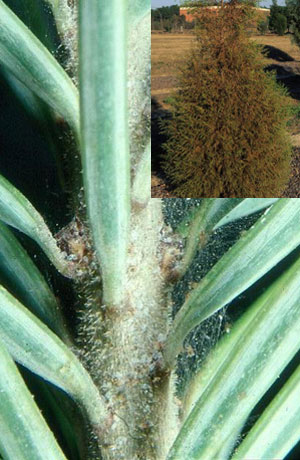
damage (inset): John Ruter, University of Georgia, Bugwood.org; close-up: Ward Strong, BC Ministry of Forests, Bugwood.org
Spruce spider mite adults are 1/64 inch and can be dark brown, reddish, or dark green in color. They are cool season mites and problems can peak early in the growing season or in the cooler summer or autumn months. They create patchy bronzing damage, dieback, and premature needle drop.
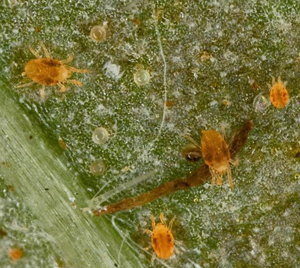
David Cappaert, Bugwood.org
Twospotted spider mites are tiny (1/50 inch) arthropods with a dark spot on each side of the oval, light green to yellow body. They live on the underside of leaves and use needle-like mouthparts to remove the contents of individual cells. This produces tiny white to yellow spots on leaves, sometimes called flecking or bronzing. These mites produce fine silk-like webbing that often covers infested plants. Infestations are usually most serious during hot, dry periods.